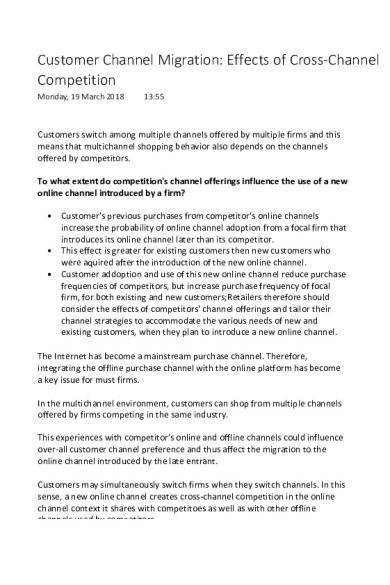Customer Channel Migration Effects of Cross-Channel Competition PDF

| Title | Customer Channel Migration Effects of Cross-Channel Competition |
|---|---|
| Course | Multichannel Marketing Management |
| Institution | Middlesex University London |
| Pages | 4 |
| File Size | 65.5 KB |
| File Type | |
| Total Downloads | 24 |
| Total Views | 170 |
Summary
Customer Channel Migration Effects of Cross-Channel Competition...
Description
Customer Channel Migration: Effects of Cross-Channel Competition Monday, 19 March 2018
13:55
Customers switch among multiple channels offered by multiple firms and this means that multichannel shopping behavior also depends on the channels offered by competitors. To what extent do competition's channel offerings influence the use of a new online channel introduced by a firm? •
• •
Customer's previous purchases from competitor's online channels increase the probability of online channel adoption from a focal firm that introduces its online channel later than its competitor. This effect is greater for existing customers then new customers who were aquired after the introduction of the new online channel. Customer addoption and use of this new online channel reduce purchase frequencies of competitors, but increase purchase frequency of focal firm, for both existing and new customers;Retailers therefore should consider the effects of competitors' channel offerings and tailor their channel strategies to accommodate the various needs of new and existing customers, when they plan to introduce a new online channel.
The Internet has become a mainstream purchase channel. Therefore, integrating the offline purchase channel with the online platform has become a key issue for must firms. In the multichannel environment, customers can shop from multiple channels offered by firms competing in the same industry. This experiences with competitor's online and offline channels could influence over-all customer channel preference and thus affect the migration to the online channel introduced by the late entrant. Customers may simultaneously switch firms when they switch channels. In this sense, a new online channel creates cross-channel competition in the online channel context it shares with competitoes as well as with other offline channels used by competitors
channels used by competitors. MULTICHANNEL SHOPPERS: • • •
Multichannel shopper constitute over 80% of the consumer market; Spend approximetly 3 or 4 x more then single-channel customers; Buy substantially more and more valuable than sigle-channel users;
Managers thus need to have clear knowledge about how customers choose and migrate among multiple channels, especially in a competitive multiretailer setting. Existing literature indicates that prior channel usage greatlly affects subsequent channel choice and migration, and customer shopping behavior depends on competitors actions. The effects of cross-channel competition on customers migration to a new online channel of a focal firm and distinguish between the firm's existing and new customers on the basis of their time of aquisition by the focal firm. THE CONSEQUENCES OF OF CUSTOMER ADOPTION OF A NEW CHANNEL: • •
Benefits of introducing new online channels: m ore revenues, increased customer retention, greater customer loyalty Other studies argue that online channel adoption increases average service costs, while diminuishing customer purchase frequency.
DRIVERS OF CUSTOMER CHANNEL CHOICE: Individual differences, marketing, channel attributes, social influence , channel integration and situational factors. Two important factors that could potentially impact customer channel choice when switching from competitor's channels to the channels of the focal firm: • Customer learning: Learning has a profound influence on customer channel choice. Customers learn from their previous experiences with firms and channels and these experiences impact their subsequent channel decisions such as channel choice and migration. Internet knowledge and previous online shopping experiences eliminate the perception of the risk of shopping online and enhance online purchase intention. • Switching costs: switching cost is related to learning effects as it
•
Switching costs: switching cost is related to learning effects, as it consists of both learning cost and transactional cost. Online customers can more easily switch among firms because they have instant access to the websites of different firms. Thus customers incur lower switching costs in changing providers.
EFFECT OF ONLINE CHANNEL ON THE PERFORMANCE OF OFFLINE CHANNELS: •
•
• •
•
• •
An online channel introduction can improve the performance of the focal firm through changes in the revenues and costs related to serving customers; Online channels contribute to profitability by increasing customer revenues: customers who use online channels perceive more information control and enjoy greater convenience and accessibility, therefore, online usage is associated with higher customer revenue and retention; An online channel increases customer profitability by reducing the costs required to serve customers.; An online channel can support and complement other channels from the same firm. Therefore, the overall performance of a multichannel system is greater than the sumof the performance of each individual channel. However other studies argue that online introductions increase average service cost and find (minimal) cannibalization between online and offline channels. In addition, online channels can increase free riding, which means online shoppers can easily switch firms. Online channels can diminuish customer profitability by allowing for lower purchase frequency....
Similar Free PDFs

Migration
- 5 Pages

Compendium of moot competition
- 50 Pages

In the channel of distribution
- 10 Pages

Migration cellulaire
- 7 Pages

THE EFFECTS OF CORRUPTION
- 5 Pages

Environmental Effects OF Quarrying
- 18 Pages

2... Effects OF Privation
- 2 Pages

Customer Satisfaction OF Adidas
- 54 Pages

Principles of Customer Service
- 18 Pages

Physiological Effects of Massage
- 8 Pages

Legal effects of marriage
- 34 Pages
Popular Institutions
- Tinajero National High School - Annex
- Politeknik Caltex Riau
- Yokohama City University
- SGT University
- University of Al-Qadisiyah
- Divine Word College of Vigan
- Techniek College Rotterdam
- Universidade de Santiago
- Universiti Teknologi MARA Cawangan Johor Kampus Pasir Gudang
- Poltekkes Kemenkes Yogyakarta
- Baguio City National High School
- Colegio san marcos
- preparatoria uno
- Centro de Bachillerato Tecnológico Industrial y de Servicios No. 107
- Dalian Maritime University
- Quang Trung Secondary School
- Colegio Tecnológico en Informática
- Corporación Regional de Educación Superior
- Grupo CEDVA
- Dar Al Uloom University
- Centro de Estudios Preuniversitarios de la Universidad Nacional de Ingeniería
- 上智大学
- Aakash International School, Nuna Majara
- San Felipe Neri Catholic School
- Kang Chiao International School - New Taipei City
- Misamis Occidental National High School
- Institución Educativa Escuela Normal Juan Ladrilleros
- Kolehiyo ng Pantukan
- Batanes State College
- Instituto Continental
- Sekolah Menengah Kejuruan Kesehatan Kaltara (Tarakan)
- Colegio de La Inmaculada Concepcion - Cebu




